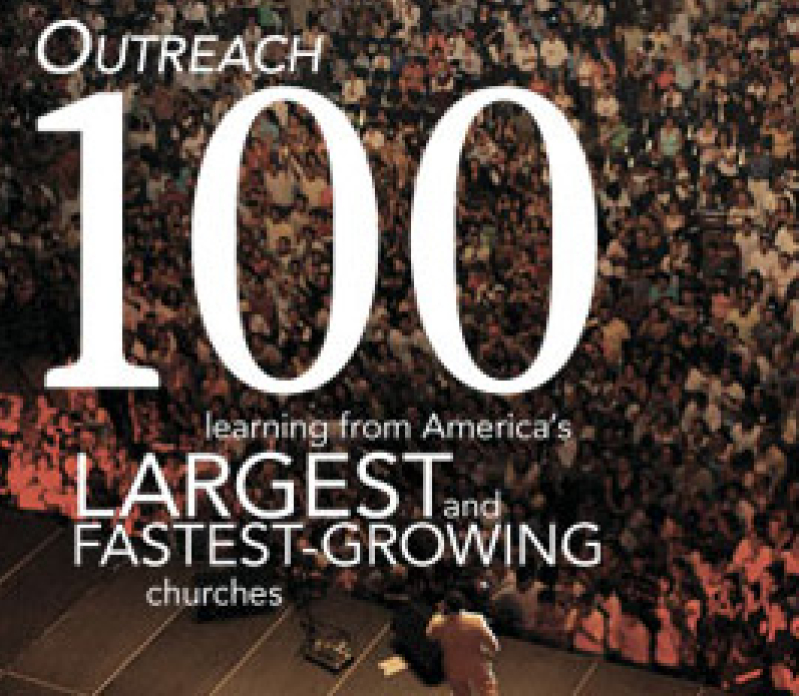
With the number of megachurches in America growing at an increasingly rapid rate, the largest of them all now have a new label: "gigachurches."
Topping this year's largest churches in the country is Lakewood Church in Houston, with an attendance of 47,000, according to Outreach Magazine's annual 100 list of America's largest and fastest-growing churches. While Lakewood remains on top, 36 of the top 100 draw 10,000-plus people each week (gigachurches). The rest have a weekly attendance of 6,000-plus.
Meanwhile, megachurches (2,000-plus attendees) now number an estimated 1,300. While that's only 0.4 percent of all U.S. Protestant churches, megachurches are growing rapidly as they pioneer new approaches largely to engage the unchurched population.
"At a time when an estimated 70 percent to 80 percent of U.S. churches are either in plateau or decline, I am encouraged to discover a number of healthy congregations on the Outreach 100 lists that are bucking the negative tendencies prevalent in so many U.S. churches," said Dr. Ed Stetzer, director of research and missiologist in residence for LifeWay Research. Outreach partnered with Stetzer for the first time for this year's top 100 which was based on new methodology that factored in both numerical and percentage growth in attendees..
This year's fastest growing church is Hispanic megachurch Iglesia Cristiana Segardores de Vida in Hollywood, Fla. Within the last year alone, the church grew by 2,800 attendees and now claims almost 6,000. The 100 churches on the fastest-growing list grew four times faster than churches on the largest list.
A key growth trend, or megatrend, is multi-site technology. Currently, seven of the top 10 fastest-growing churches are multi-site churches in which churches have set up extension sites on multiple campuses across the city, state or country. In 1990, there were only 10 multi-site Protestant churches in the United States. Today, 25 percent of all megachurches have more than one site and 16 percent of all Protestant churches in the United States are seriously considering adding a site within the next two years, according to LifeWay Research.
Stetzer doesn't consider multi-sites a trend anymore, but rather as "the new normal."
And the multi-site phenomenon continues to morph and transition as churches find new forms of expression to run church activities in many locations.
LifeChurch.tv (No. 40 Fastest-Growing, No. 5 Largest), stationed in Edmond, Okla., has launched sites across borders to Arizona, Texas, Florida and New York, as well as on the Internet.
North Coast Church in Vista, Calif., uses its multiple campuses to engage different cultural segments and reach different generations with a range of worship experiences – from traditional (hymns) to postmodern (sub-woofers, candles).
Other multi-sites have chosen to create smaller, more intimate faith communities at their satellite locations, either offering services of only 200 people or even smaller to a house church.
Another type of megachurch Stetzer noted includes churches using their platform for political action in new ways.
While Christian churches have long been perceived as monolithically right wing, more megachurches today are tackling issues not historically connected with those of the Religious Right.
Hispanic churches have risen to the frontlines of the immigration reform battle, black churches are voicing themselves on social action, and others are championing issues such as eradicating global poverty and creation care.
Ethnic diversity is also a noted megatrend as Hispanic and Asian congregations continue to increase in the United States. While the growth of the Hispanic population and churches is already evident, Stetzer predicts more Asian congregations will appear on the Outreach 100 list in the future.
More megachurches today are also returning to the foundational ethic of multiplication through discipleship. That's a turn from the emphasis on personal self-help and church growth methods that have been seen in the megachurch phenomenon.
As experts have concluded, Stetzer sees no slowing or halt to the megachurch phenomenon as long as pastors continue to seek new ways to reach and transform their communities for Christ.
Top 10 Largest U.S. Churches
1. Lakewood Church, Houston Texas – Joel Osteen (47,000)
2. Willow Creek Community Church, South Barrington, Ill. – Bill Hybels (23,500)
3. Second Baptist Church, Houston – Ed Young Sr. (23,198)
4. Saddleback Church, Lake Forest, Calif. – Rick Warren (22,000)
5. LifeChurch.tv, Edmond, Okla. – Craig Groeschel (19,907)
6. Southeast Christian Church, Louisville, Ky. – Dave Stone (18,013)
7. North Point Church, Alpharetta, Ga. – Andy Stanley (17,700)
8. Thomas Road Baptist Church, Lynchburg, Va. – Jonathan Falwell (17.445)
9. Calvary Chapel Fort Lauderdale, Fort Lauderdale, Fla. – Bob Coy (17,000)
10. The Potter's House, Dallas – T.D. Jakes (17,000)
Top 10 Fastest-Growing U.S. Churches
1. Iglesia Cristiana Segadores de Vida, Hollywood, Fla. – Ruddy and Maria Gracia (3,050, 109 percent growth)
2. Calvary Community Church, Phoenix, Ariz. – Mark Martin (2,344, 26 percent growth)
3. Elevation Church, Charlotte, N.C., Steven Furtick (1,965, 444 percent growth)
4. New Life Church, Conway, Ark. – Rick Bezet (2,000, 108 percent growth)
5. Valley Bible Fellowship, Bakersfield, Calif. – Ron Vietti (3,600, 52 percent growth)
6. Fellowship Church, Grapevine, Texas – Ed Young Jr. (3,000, 30 percent growth).
7. Thomas Road Baptist Church, Lynchburg, Va. – Jonathan Falwell (4,750, 37 percent growth)
8. The ROC (Richmond Outreach Center), Richmond, Va. – Geronimo Aguilar (2,100, 100 percent growth)
9. Redemption World Outreach Center, Greenville, S.C. – Ron and Hope Carpenter (2,000, 31 percent growth)
10. Champions Centre, Tacoma, Wash. – Kevin and Sheila Gerald (1,500, 30 percent growth)
More than 20,000 Protestant churches were contacted for the Outreach 100 lists, which includes churches that opted to participate in the study and data that each church provided. The lists are published in Outreach magazine's annual Outreach 100 Special Issue.







